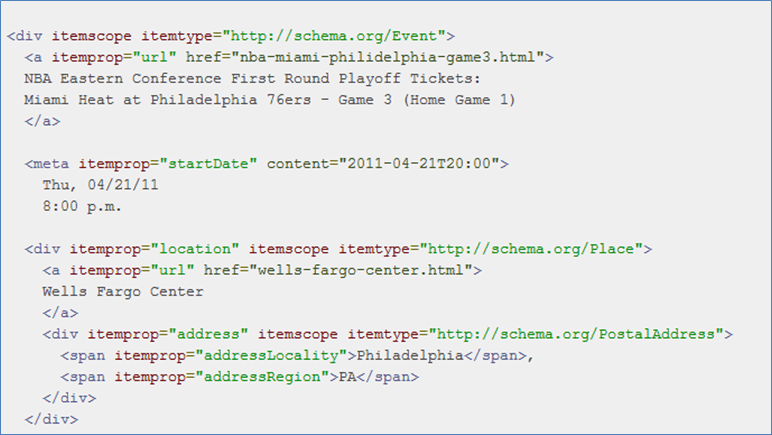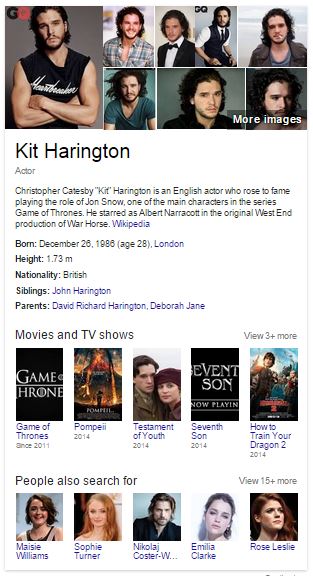Your Complete Guide to (Winning) The Knowledge Graph

WTF is The Knowledge Graph and Why Should My Business Care?
Knowledge Graph is so much more than a clever little box full of facts which pops up on the right hand side of your Google Search when you want to find out when Kit Harington’s birthday is (for totally legitimate reasons and not to find out whether your star signs are compatible). It’s a tool, it’s a concept and it could underscore a marked change in the way we use search engines in the future…
But for now, the Knowledge Graph is a potentially very useful thing for digital brands to get to grips with, particularly when it can be used to increase search visibility and improve accessibility to key information like opening times and upcoming events. Some digital marketers have even started to offer KGO (Knowledge Graph Optimization) services to help businesses get the most from this new feature.
That’s why we’re going to be taking some time today to unpack Google’s “box of facts” and get to the bottom of:
- What the Knowledge Graph is
- How the system works
- What it does
- How brands can leverage it for digital wins
- What the Knowledge Graph means
So, before we get too abstract and philosophical, let’s start by taking a closer look at what this helpful little fact source, added to Google searches back in 2012, actually is…
What is the Knowledge Graph?
Images, key facts from Wikipedia, dates of birth, heights, nationalities, relatives, on screen appearances, related searches, events, nutrition facts (don’t worry, we’re not talking about Kit Harington any more), definitions… The Knowledge Graph delivers all this and more, direct to your search engine results page (SERP) when you type in a particular keyword.
Designed to save searchers time by serving up the most pertinent facts and figures on distinctive topics right on screen, the Google Knowledge Graph display reduces the need for searchers to explore search results, saving us valuable time and clicks.
In fact, this development has been so successful, Wikipedia has seen a clear decrease in visits since 2012. In essence, the Knowledge Graph helps searchers get the facts, faster, without needing to look deeper into a website or a subject. This taps in to Google’s major mission statement:
“Google’s mission is to organize the world’s information to make it universally accessible and useful.” (Source)
The tool is currently used both by Google Maps and Google Now, with the short summaries it provides regularly used as spoken answers by Android’s virtual assistant.
How does the Knowledge Graph work?
This is where things get really interesting. The Knowledge Graph uses a different kind of search to the versions we’re used to. When a search engine delivers pages of websites related to your search term, it’s generally using implicit entities to find what it thinks are the best and most relevant results. When the Knowledge Graph kicks into gear, it uses a different kind of information to determine what it shows you; explicit entities.

Let’s slow down for a second. Implicit and explicit entities might sound baffling, but they’re actually pretty simple. In a nutshell, Google brings you what it thinks are the most relevant results for your search, based on the information it can mine from your website. The information “nuggets” it digs up are known as entities. Here’s the crucial difference:
- Implicit entities
These are derived implicitly from the text on a website. This sort of fact retrieval is called implicit because information has not been obviously shared in a way search engines can understand. Instead Google has to work out what the information is, based on the words on a page. It uses a natural language algorithm like NLP (Natural Language Processing) to turn the written word into inferred facts or entities it can digest and use to decide what information it shows to searchers. - Explicit entities
These are straight up facts, written in a search engine’s “language”. It is a website’s responsibility to add structured data markup that this sort of search can retrieve in order to make an appearance on the Knowledge Graph or to show up in semantic searches. Search engines can also glean this data from sources like Google+, Freebase and Wikipedia.This structured data markup is commonly created using schema, which provide standardized ways for webmasters to add this sort of data to their webpages. Just to give you a little bit of context, here’s what explicit entities (made retrievable through schema markup) look like behind the scenes…

Why this matters
The especially interesting thing about using explicit entities instead of implicit (text based) entities to search for and serve up information, is that this sort of search doesn’t see searches as strings of letters any more.
You may remember the fledgling years of SEO, when factors like keyword density made a big difference to your website’s rank. That’s because implicit searches were less sophisticated and pretty much just scoped out matching combinations of letters to determine relevance to a search term.
Today, implicit search is more sophisticated, but still treats search terms as a string of letters, when in actuality a search is all about concepts. This is something that explicit search (which deals in cold, hard facts rather than fallible human language) is really good at. It treats search terms as the objects they are, helping you find information about the concept you’re interested in, based on its relation to the rest of – well – the world!
But enough theory, it’s time to get back to some concrete ways you can embrace this technology and use it to your digital brand’s advantage…
How can you harness the power of the Knowledge Graph?

Before we tackle the “how”, it’s important to consider the “why”. Why would an online brand want to use schema, explicit entities and the Knowledge Graph? There are more good answers than you might think…
- Show Up
The Knowledge Graph occupies prominent and eye-catching spots on Google’s SERPs. If you can show up here, you can significantly improve your visibility in online searches. With Google Maps and Google Now both using Knowledge Graph data, there are even more ways to get under consumers’ cursors and swiping fingers with this technology – and this is likely to grow. - Help Out
The more helpful you can make yourself to consumers online the better. If your business’s information shows up in the Knowledge Graph, searchers have instant, useful access to key information which can give you the edge over competitors and make you a really top notch resource. Whether you’re driving consumers to your physical stores with clearly displayed opening times, or promoting an event by ensuring key dates show up, this is a feature you shouldn’t ignore. - Get Ahead of the Curve
The Knowledge Graph is still in its infancy, but semantic search which relies on schema markup is only going to grow. In recent years we’ve seen text-based search becoming less and less important. Getting started with the Knowledge Graph now will lay a firm foundation which could have long term benefit for your brand and business.
How to “get into” the Knowledge Graph
With so many incentives to get started, it’s time to conquer the Knowledge Graph. There are a number of ways you can start increasing your chances of showing up…
-
- Mark up your website
Although incorporating schema can be time-consuming, the the technique is relatively straightforward. In fact, if you can handle some basic HTML, you can start adding schema to your webpages.Effectively, you’ll be using code to tell the Knowledge Graph (as well as a wide range of other search engines) exactly what the information on your website is all about, in their own language. There are specific codes (markups) for pretty much every piece of information you might want to share, from cinema times, to how long a recipe takes to prepare.Here are some indispensable resources which will help you get started…
- Mark up your website
- Learn all about marking up your content with schema.org
- Get all of the different item types in one place
- Test out your new markup with Google Developer’s testing tool
- Here’s a handy video that will teach you how to markup events:
- Embrace Google+
The Knowledge Graph is also closely linked to Google+. For businesses with less time to arduously markup their content, a fully optimized Google+ page will help you appear in searches just like this…
- In fact, embrace all of the Knowledge Graph’s sources
The Knowledge Graph pulls information from a number of authoritative sources. High on its list you will find sites like:- Wikipedia
- Freebase
- The FDA
- Zagat
- Panoramio
Ensure you have a presence on sites like this – plus sites which are authorities in your niche to help make certain your information is right where Google can get it.
- Focus on developing authority The Knowledge Graph wants to give searchers the very best information as quickly as possible. Ensuring your website is considered authoritative is essential if you want the algorithm to trust the information you are supplying.
Growing your domain authority (DA), cultivating a positive social media presence, producing high-quality content on a regular basis, getting active on Google My Business – there are all sorts of things you can do to increase your authority, most of which is just plain good digital marketing practice.
Follow these steps and you’ll rapidly increase your chances of appearing in a Knowledge Graph search result. As you’d expect, there’s no guarantee you’ll win your slot, but as Knowledge Graph continues to grow, and semantic search becomes more and more important, getting a head start with this stuff could be a real feather in your digital cap.
Schema.org markup is a part of our Managed Monthly SEO Services, feel free to get in touch with us if you need help!




